
|
A Secondary Venue for an Equipment Junkie

|
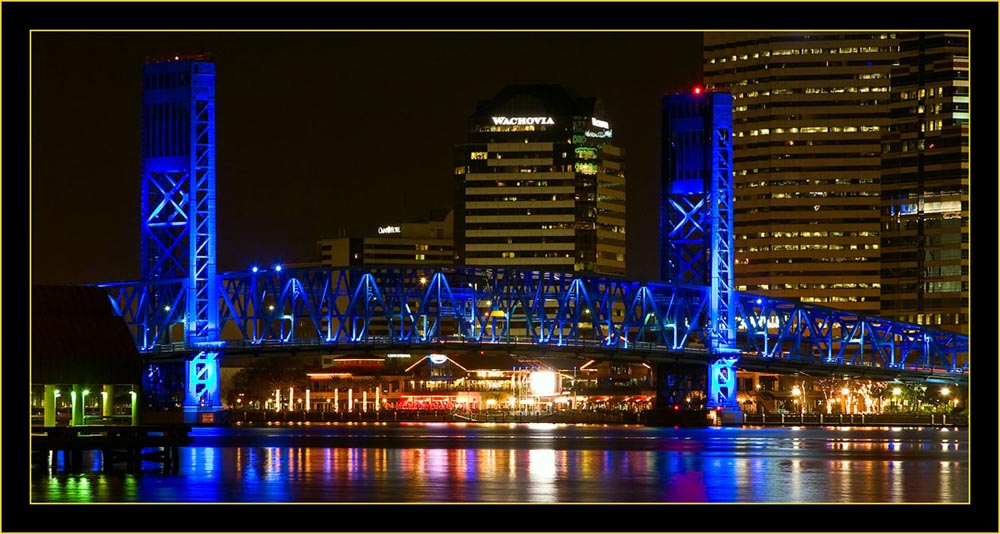
|

|
On March 16th along with friend & fellow imager, Doug Herrick, we traveled to Tybee Islands North Beach. There is always a variety of birds around the beach and generally one large flock somewhere in the vicinity. We hoped to locate/photograph some American Oystercatchers stated as being in the area and whatever else may be around this particular Sunday. We parked the vehicle, gathered our equipment and started walking the beach... American Oystercatcher - Canon 1Ds, 1/250th second, ISO 640, 840mm at f/8, camera on tripod. |
|
We found the flock, minus any oystercatchers, but included were a large group of Black Skimmers, various gulls, terns,
Sanderlings, etc. We set our tripods low and were
photographing birds from a kneeling position as we approached the group. The skimmers have a habit of taking off every now and then when theyd fly around for a time
and land, usually only a matter of yards from where they started. After a time we decided to get some shots of the chaotic state when the skimmers became airborne so
left the tripods about fifty feet from the waters edge and were handholding our cameras with 400mm f/5.6L lenses. Doug had one camera on the beach this day - in his hand,
so his tripod was empty. I had my 500mm f/4L lens, Canon 5d (my primary camera) and a 1.4X extender mounted on my tripod as usual. A container ship was going by in the
channel as we followed the flock down the beach I never gave this a thought at the time although I thought about taking some shots of the vessel. After eight or
ten minutes a tsunami bow wave from this ship could be viewed rolling towards the beach. We both viewed the incoming wave oh no, this isnt good - but were too
far away from the tripods to get to them before it struck. The gear stood as the wave cascaded up the sand but the backwash carried both tripods out with it as we ran to retrieve
the gear. I could see my lens/tripod going end over end in the surf as I was running towards it. As sad as this was I had to laugh a bit as I ran along about allowing
something so preposterous (and expensive) to occur. Doug arrived first on the scene of the disaster and pulled both tripods from the sea. We went home and rinsed the
gear as best we could but it was not an encouraging situation...
Herring Gull - Canon 5D, 1/640th second, ISO 400, 700mm at f/10, camera on tripod.
|
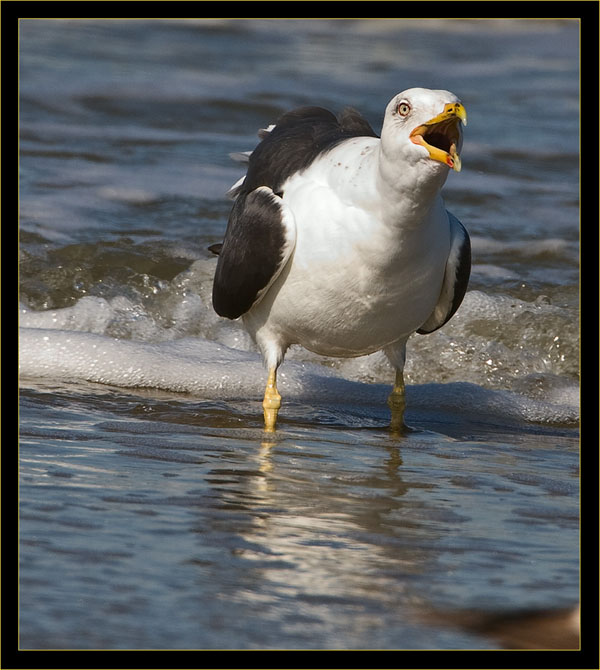
|
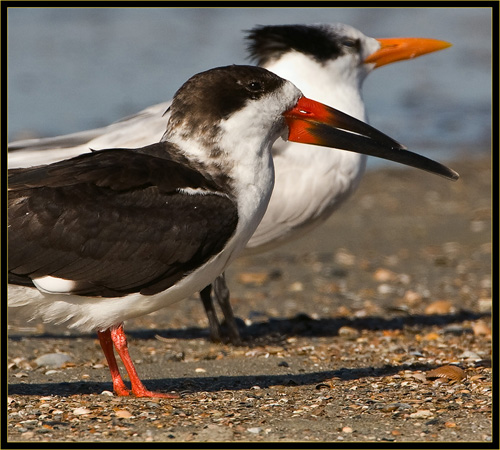
|
Flash forward several months... upon returning home and sending my EOS 5D, 1.4 X extender and 500mm f/4L lens out for repair evaluation, I learned that nothing could be done or it wasnt economically feasible to do so. The lens in particular was a significant loss as wed shared many adventures together. Everyone asks so Ill state it here No, I didnt have insurance for this situation. Id checked into it but never followed up... What I learned from this debacle: 1) be extra careful where you leave your tripod should you need to walk away or dont leave it; 2) and make your insurance person a personal friend of yours... My Gitzo CF 1325 tripod and Really Right Stuff BH-55LR ballhead and Sidekick survived the debacle and remained in use. Other than these items all that proved salvageable was the media card - images intact and the twin 5D batteries. You can bet I took time to insure all my camera and telescope gear when I returned to Maine. Black Skimmer standing next to a Royal Tern - Canon 5D, 1/800th second, ISO 400, 700mm at f/8, camera on tripod. |
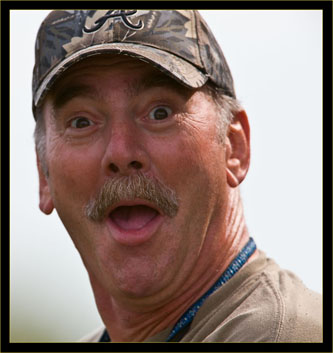
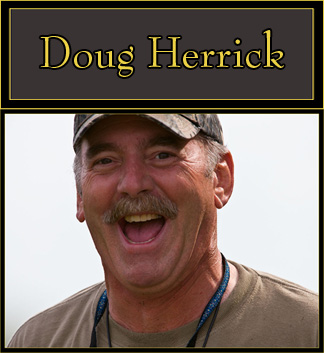
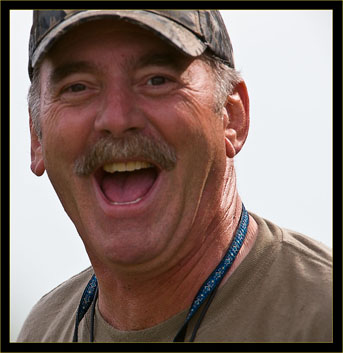
|
|
Finally the reality of this situation came home to roost. Ill pretty much photograph anything that strikes my fancy but bird photography is something I truly enjoy. When I returned to
Maine the spring migration would soon be underway and Id be without a long lens if I sent it out for service. At this time I didnt realize my 500mm f/4L wouldnt be
repairable although I figured the camera was all done. Id been on the list for a Canon's top of the line professional body, the EOS 1Ds Mark III for several months waiting for the supply to catch up with
the demand and had some savings related to this, so I decided to act while still in Georgia. I didnt need to do additional research as my long range equipment plans had been
identified for some time. I had no idea how much I would miss the full frame sensor of the 5D until I didnt have one, so in the first step I decided to replace this immediately.
The more I thought about the lens and trust me I thought about it a lot I decided to do something about this as well. I replaced it with a 600mm f/4.0L IS
lens Canons big daddy. (Note: the Canon EF-800mm f/5.6L had been announced as coming at the time but was not yet available. Even I couldn't justify an additional $5k over the 600mm for this lens in any event.)
This was pricey but I suppose one can justify anything in similar circumstances including the fact that I use my equipment whenever
the opportunity presents. And it got worse I did all this properly including adding a new heavy duty Gitzo GT5530S CF Tripod and a Wimberley Head II to mount
the lens besides replacing my 1.4x extender.
The new Canon EF 600mm f/4L IS lens mounted.
|
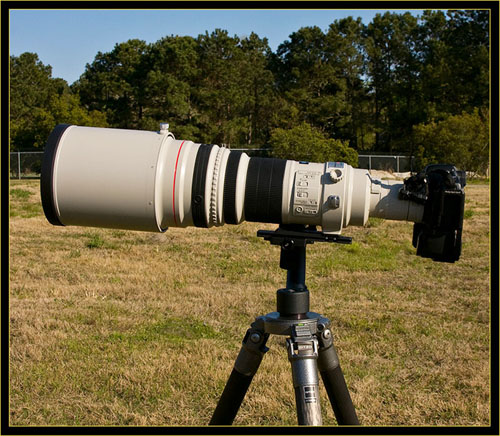
|
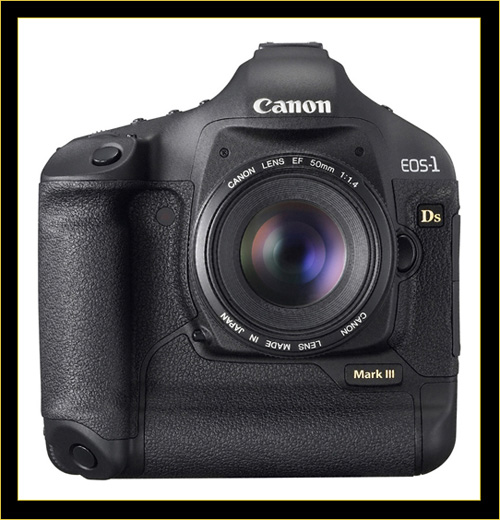
|
A few days after this re-gearing frenzy, both exciting and downright frightening, I received a call from Hunts and was informed a Canon EOS 1Ds Mark III camera came in earmarked for me.... Now how ironic is that? Yikes Id been able to justify everything so far with the bit of savings allocated to camera purchases and some planning, however this put things in an entirely different perspective. At first I was non-committal indicating Id be home in several weeks, etc. etc, I wasn't certain what to do. But within a day or two I purchased this camera as I wished to push my efforts to a new level. I'd skipped the Mark II generation entirely waiting for the Mark III series and now one was available. The 1Ds Mark III represents my first professional camera of the four I own and constitutes by far the largest investment. |
|
It may be needless to indicate but the 1Ds Mark III is a truly amazing camera. Ive taken around 2,000 images with it and am starting to get comfortable with the menus and set up.
The resolution is incredible and it didnt take long to appreciate the outstanding image quality. Utilizing this camera and the 600mm lens extended to 840mm is a bird imager's dream.
While in the field these days my system consists of the 1Ds Mark III body, 600mm f/4L lens, usually extended at 1.4X tripod mounted & supported by a Wimberley Head II. My handheld system carried on a strap to my left side generally is the 5D body with a 400mm f/5.6L lens; sometimes a shorter focal length lens is employed but if Im planning on shooting a wider field I have no problem using the 40D and whatever lens for this purpose. Going into summer 2008 finds me re-geared and ready to go. I look forward to many successful photographic endeavors...
|
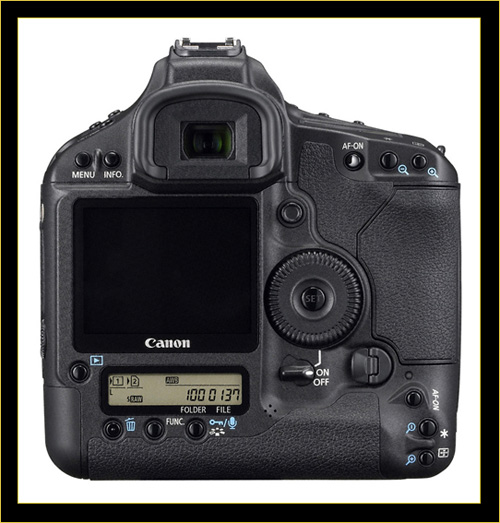
|
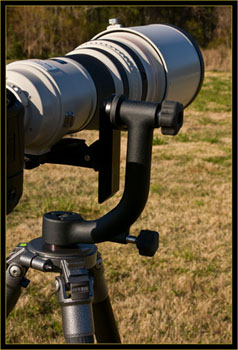
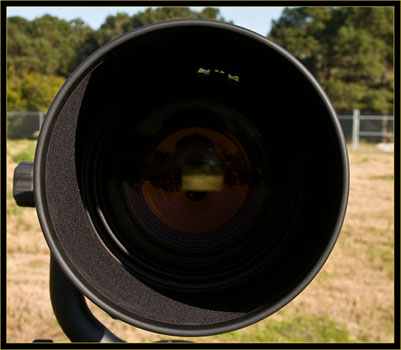

|
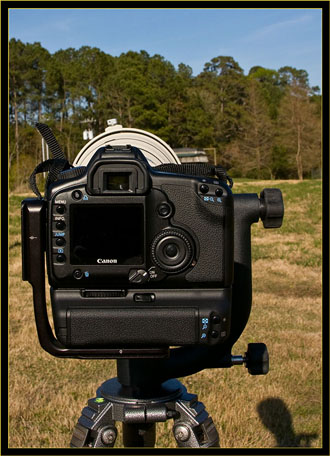
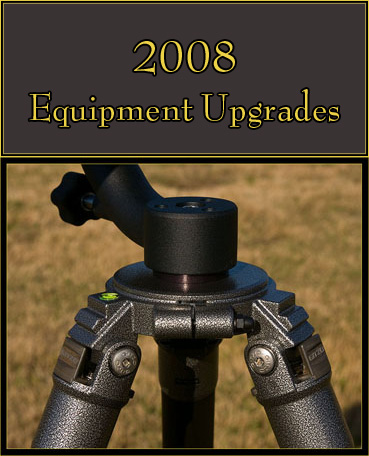
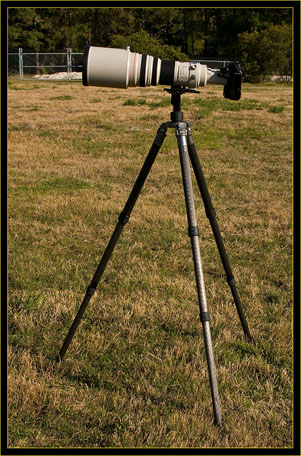
|

|
This is image file 003 off the 1Ds. I was out with another good friend from Georgia, Fitz Clarke, who is immensely interested in shooting insects of all kinds but has a particular interest in damsel and dragonflies. It was a windy day and I thought our efforts would be wasted as these small creatures were nearly always in movement, even in slight breeze. Ramburs Forktail 1/80 second, f/7.1, 400 ISO at 200mm. This shot was taken with my Canon 70~200 f/2.8L IS lens with a 12mm extension tube. I use this set up often when doing macro work. Another interesting aspect of this shot was that it was done using the live view function of the 1Ds. |
|
Sandwich Tern at Tybee Island, Georgia. Several of us were on the beach this day seeking out these terns to photograph the peach blush coloration they obtain during breeding season.
You can note this blush even in this reduced image.
Sandwich Tern - Canon 1Ds Mark III & 600mm f/4L lens; 1/125th second at f/8, ISO 400 at 840mm.
|
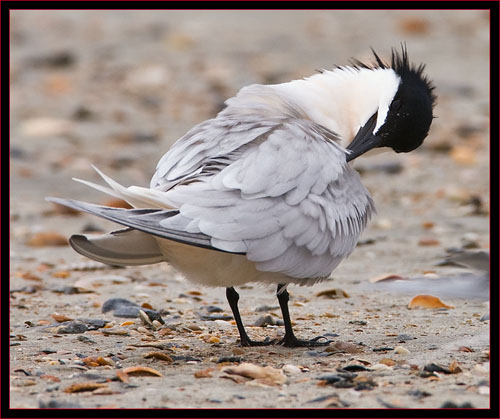
|



|


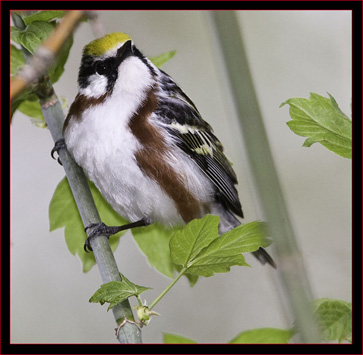
|

|
Forster's Tern on Tybee Island's North Beach - 1/400 second, f/8, 640 ISO at 840mm |
|
Female Cowbird - In my view this image demonstrates the resolution of the 1Ds quite well. The master file of this shot is outstanding.
Brown-headed Cowbird - Canon 1Ds Mark III & 600mm f/4L lens; 1/80th second at f/8, ISO 400 at 840mm.
|

|

|
White-breasted Nuthatch in a typical pose. I can't say with absolute certainty without checking, but I believe this may be the best nuthatch shot in the many I've archived - 1/60 second, f/7.1, 400 ISO at 840mm; flash was employed on this shot. |
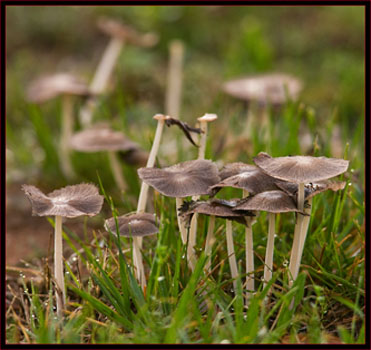
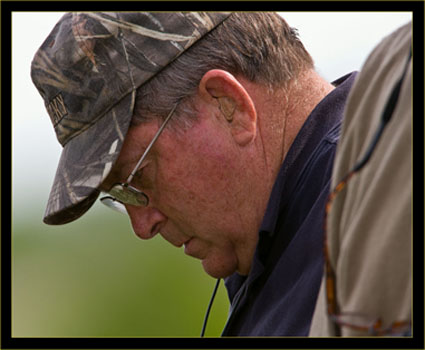

|
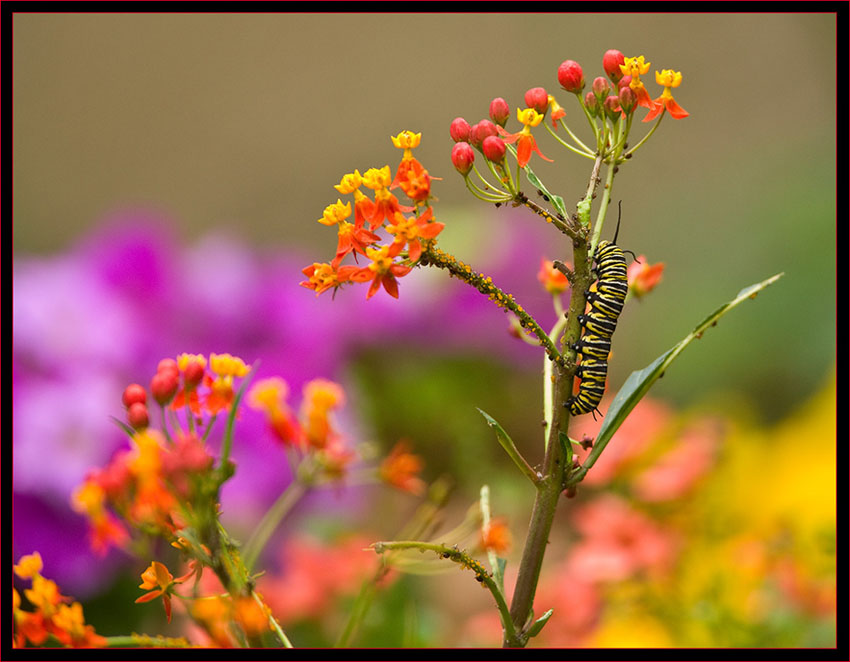
|
|
|

|
I waited for a full frame sensor camera to become available so I could shoot 35mm without the conversion factor. When Canon introduced the EOS 5D digital SLR it wasnt long before I bought one. I should point out that I dont buy anything without a good bit of research - talking to people that know about whatever the subject is and reading whatever I can to learn about the item from available sources. Ive been using the 5D since November of 2005 and find it to be capable of producing great images and is a first-rate camera overall for my purposes. The 12.8 Megapixel CMOS sensor provides excellent resolution. Im able to enhance and print the 5D files at my usual size of 16 X 20 with what I view as outstanding results. The accessories I deemed as required included a BG-E4 battery grip Id learned that the extra battery power and balance provided with a battery pack was an asset and a 430EX Speedlight as the 5D doesnt have a built in flash. I owned a compact Manfrotto tripod (Model 681 SHB) and recently added a monopod as well as a Canon TC-80N3 Remote Timer Controller for when I use the 5D in astrophotography applications. Previous to purchasing the Canon 5D, Id always been a Nikon shooter; however, as I anticipated making the change over to digital I believed Canon had the edge as indicated from my research. None of my Pentax or Nikon lenses were suitable for the digital age so I was starting out from scratch and decided to purchase Canon equipment. This in no way should indicate that I believe Canon is superior in all regards or that Nikon doesnt produce products that are equivalent. |
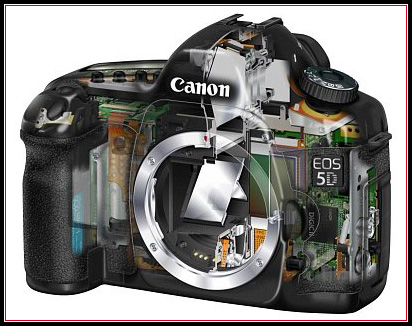
|
I purchased an inexpensive lens with the 5D so Id be able to shoot some images. Due to the cost of lenses I decided to start out with just a few but these would be the best I could afford. So, my research centered on the Canon L series lenses, the best Canon produces.
My thinking was I could always add new lenses as time and expendable income became available. As Im not trying to generate income photographically, money was a consideration.
It wasnt long afterwards that I made a decision as to the first lens to purchase. What Id read indicated a
fast, wide zoom would be great for interior images. The 5D doesnt have a built in flash so I was looking at the more expensive f/2.8 lenses hoping to not always have a flash on the camera.
The EF 16~35mm f/2.8L USM Ultra wide zoom fit the profile perfectly and this is what I purchased. This lens fairly well lived on my camera and I have taken many interior shots with it without ever
using my EX430 Speedlight. This lens is astounding in use at lowlight levels. Id like to thank Michael Reichmann and his Luminous Landscape website for his excellent information, reviews and opinions of all things photographic in aiding me with this choice. If you're into photography in any fashion you should be investigating his site. |
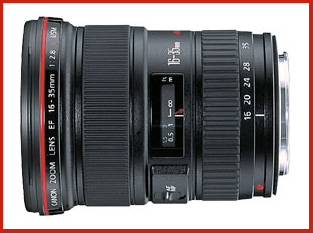
|
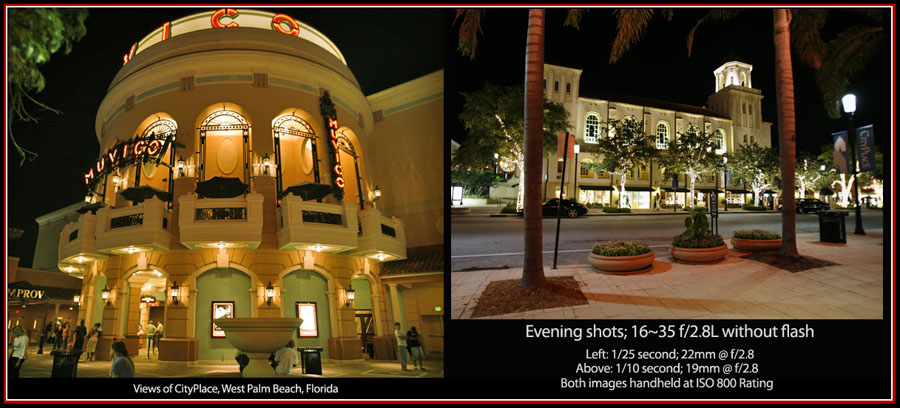
|
In my view this lens is quite capable for low-light imaging as exhibited above. It is fairly exceptional for interior views as well. Below is a photograph of the astronomy display in my Portland office. These ArtiPlaq hangings represent a sampling of the astronomy images I display and sell. Collectively they make a wonderful and eyecatching display and I've received many compliments pursuant to the content and exhibit. This shot, cropped from a 16mm frame was lightened/enhanced in Photoshop CS2. Perhaps not fine art, but all the same it is impressive to get a usable image shooting in low light without a flash. This lens has been a true asset when shooting in resident units in the complexes we renovate at work. I handheld the camera so the image isn't as sharp as it could be; certainly this is no fault of the lens.

|
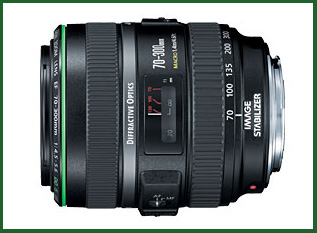
|
Id traveled to Savannah, Georgia for St. Pattys Day in March of 2006 (always a grand time) and while there had an opportunity to image some birds and other wildlife. It didnt take long to figure out my two lenses werent suitable for this endeavor although some decent images came out of the trip. I got to thinking about a longer lens with enough reach to shoot birds, zoom in on people, places, etc., that would add a bit more versatility. The EF 70~300 DO IS was what I elected to purchase next. Although not an 'L' series, this design is unique allowing the lens to be light weight (1.6 pounds at 3.9" long) and it has a terrific range in a compact package. I use this lens often when shooting birds around the yard and for general purpose imaging including macro shots - the minimum focus distance is 1.4 meters - not bad when extended at 300mm. I recently uploaded a grouping of animal images; below are two that I didnt use in that venue. If youd like to see the enlarged versions I did include, which I believe are far superior, please check the article out here: Backyard Critters. I don't have enough experience to compare this lens to the plethora of others Canon has available but I would comment that I'm quite satisfied and would recommend this lens without equivocation. |
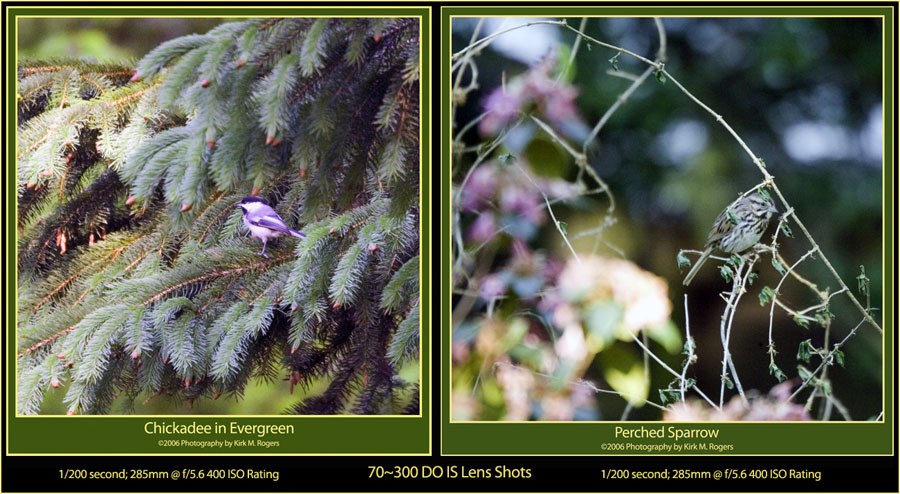
|
The 70~300 DO IS also works well for landscapes on the wider end of its range. The Florida images below were exposed right after the Sun dropped under the horizon and illuminated the sky beautifully. The 5D was handheld for these exposures.
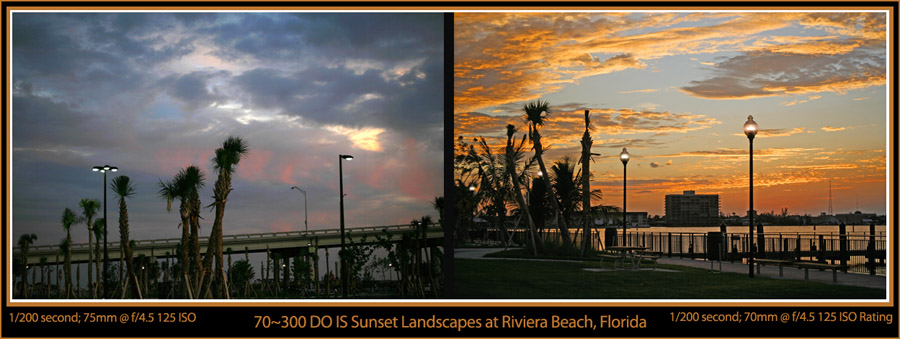
|
|
One lens I really wanted to purchase was the EF 70-200 f/2.8L telephoto zoom with image stabilization. This is a fairly pricey optic so I didnt think about acting on
it anytime soon. In the end result, some friends of mine got together and purchased a 100~400 f/4.5-5/6L IS lens for my birthday (what can one say about friends like that!).
I evaluated this lens for several days and didnt think all that highly of it so traded it in for the 70~200mm IS. Afterwards I found the RAW files imaged after the first day
with the lens were quite good, but I stuck with my plan and followed through on the exchange. In retrospect, the first go round in testing the 100~400mm was on a day with a bit of Maine fog in the air
in Portland Harbor, which impacted the quality/sharpness I was seeking. I didn't believe the lens was what I'd expected shooting wide open at 400mm. Time will tell if I made the correct choice.
On the other hand I never read about anyone not thinking the 70~200 f/2.8L IS lens is anything but superb for its focal range.
It appeared I was going to have to wait for a 70~200 IS to come in at a local camera shop but it was less than a week's wait time and I was surprised to come home one evening to find it had been delivered. When purchasing astronomy equipment waiting six or eight months is normal so this was a pleasant surprise indeed. This lens and the two identified below are new to my system. Actually all the lenses are fairly new to my system as I've been gearing up (first half of 2006). |
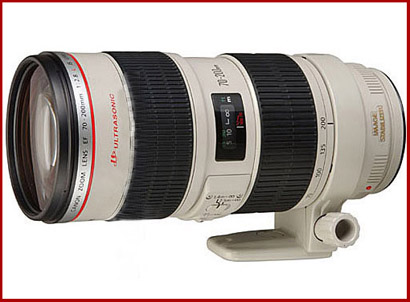
|
Our weather at the time the 70~200 f/2.8L lens arrived has been dismal, having rained for several weeks. This is unusual where we live and it really kept everyone indoors much of the time. However, we finally viewed the Sun on a nice Sunday and this was my opportunity to try out the lens. So rather than pull the Harley out, just in case, I put the camera gear in my truck and headed out to check out a few spots for test images. The images below were taken at the Fore River Sanctuary, my second stop of the day. The nature trail was a bit disappointing as I was seeking birds, so I took some landscape shots including these. I added the Canon EF 2x II Extender as I was interested in learning how this would work at 400mm. Both were shot in Aperture Priority at an ISO rating of 100 using a monopod for support. These were shot in RAW format and both are cropped from the masters to reduce the file size. I used some lab color in the culvert shot and thought I took a mundane shot and gave it some character - but you'll have to be the judge...
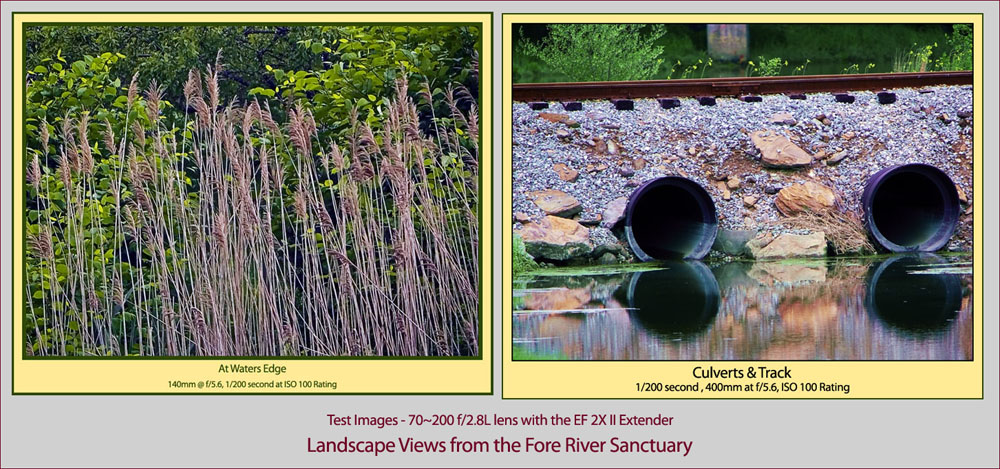
|
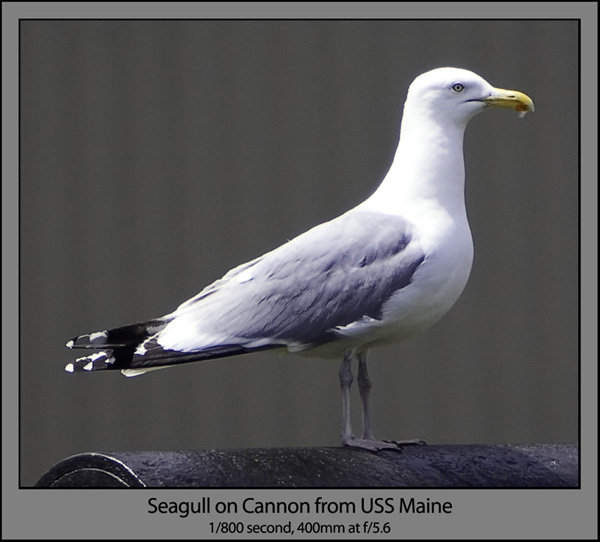
|
The first stop I made was at Portland Harbors Eastern Promenade. Many people were out and about pleased to see it wasnt raining Im certain, but not much for birdlife, the usual Seagulls and some songbirds here and there. Seagulls make good test subjects however and I shot one fine example on two separate occasions as he would fly around and come back every now and then. The two shots of him are in different locations actually. I didnt want you to think the head shot was a crop of the first because it isnt. He was actually perched on a lamppost in the portrait view. |
|
I like both these Seagull images and have nothing but good things to say about the 70~200 f/2.8L IS lens at this point. Both of these images were shot with the 2X extender with the lens wide open.
You lose two stops with the extender so these were taken at f/5.6. I believe the image quality of this lens is every bit as superb as what Ive read in various accounts.
Even in these significantly reduced web versions one can really get an idea of how sharp the optic is. Both seagull photographs were shot in Aperture Priority at 400mm; I kept the lens open and let the camera select the shutter speed. They were cropped to reduce the file size and enhanced in Photoshop CS2. I used Pixel Genius Photokit Color II and Photokit sharpening programs on the images. Ive gained a new respect for bird imagers that can track and shoot a bird on the fly. Even a fairly large bird like a seagull is a task Autofocus is a wonderful thing but it isnt much good if you cant keep the target in the field of view. I also learned that locating birds in bushes and trees isnt significantly easier than finding deep space object with a telescope finder. I would comment however that this acquired skill has served me okay in this new adventure. You learn to sight down a telescope tube to get in the correct area after a bit of practice and using a camera isnt that much different. Because I used a monopod for the shots I took on this day, I actually didnt try to handhold the camera and follow many birds. I read somewhere that when using an image stabilized lens on a support to set the lens on IS two; I did this and it appeared to work well. |
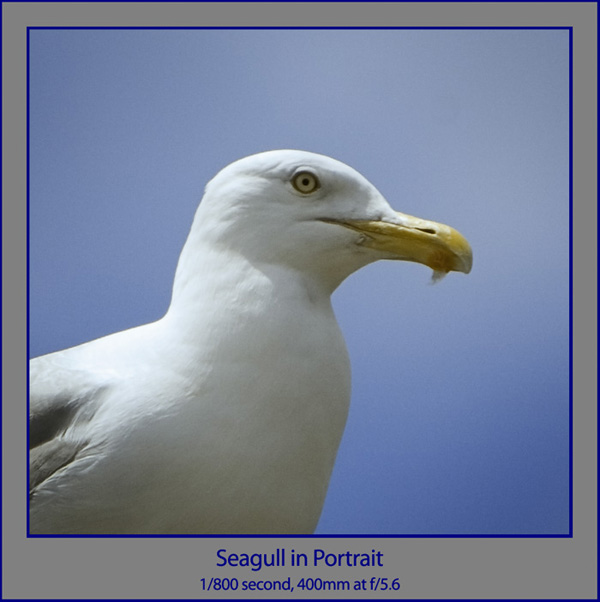
|

|
I know, I know, this is just a Pigeon taking off, but remember, I was testing the lens and I just happened to be at the right place when this bird decided to launch out I actually like this shot regardless of the subject matter. It was a challenge to enhance and all things considered I thought it came out well compared to the RAW image. I learned that 1/500 second isnt enough to stop a birds wings in motion if nothing else. I caught this Pigeon just as he was leaving the roof in view. This also speaks well of the 5Ds autofocus abilities because I saw the flight commence out of the corner of my eye, swung the monopod around and took a quick shot. Even if planned it probably wouldnt have been any better than this and it was good practice. |
|
To the right is a photograph I took while in Baltimore. A group of us attended an Orioles game - they lost but we had a good time; this tower is nearby and
the area around the ballpark provided a good vantage point for this image.
This is somewhat of a landmark in the Inner Harbor area and the building is no larger in width or breadth than this tower depicts. Bromo Seltzer was a booming company until several decades ago
and I doubt the building is used for anything now. I cropped this shot just above a hotel in the foreground. I wished to capture and emphasize the clock; you can see the time
easily enough in the image. This photo was taken with the 70~200 f/2.8L at 110mm focal length at f/5.6, 1/500 second. This lens really is a good performer.
|
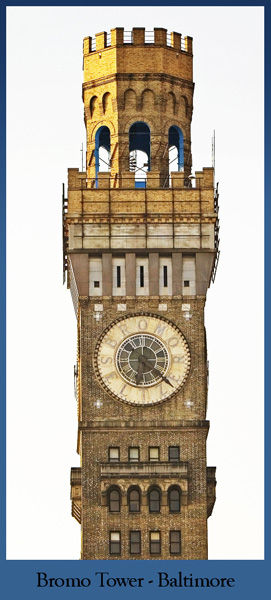
|

|
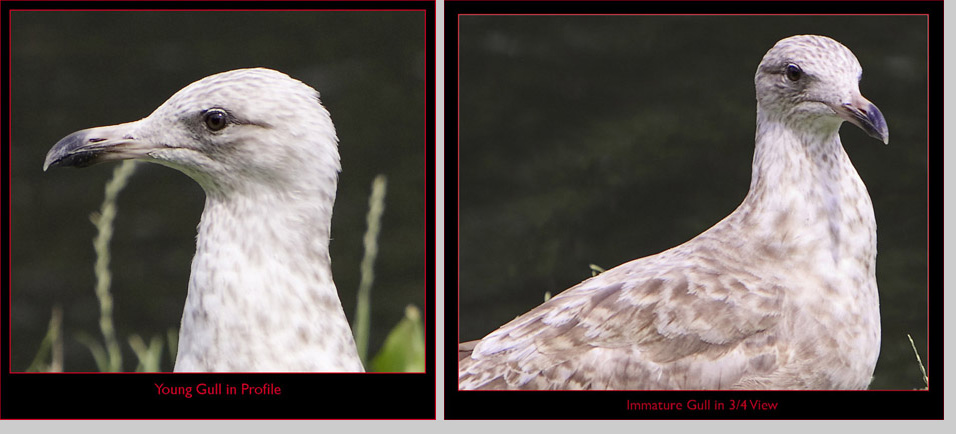
|
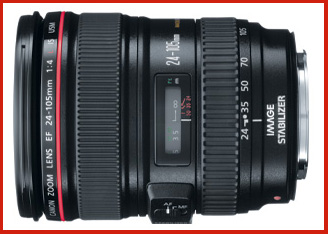
|
This is one of the newer lenses to be added to my system, the EF 24~105 f/4L IS USM. As indicated above, it is so new it hasnt been evaluated quite yet. This is another lens that comes highly regarded and
is a standard zoom that will broaden my range. At this point Im where Id wished to be for my basic lens set. I must say that I'm impressed with the build quality of the Canon 'L' series
lenses. These aren't inexpensive but I believe they provide an excellent value and include a soft case, caps and a lens hood as part of the package. This series is designed for professional
use; with as much as I shoot in relation to a pro, somebody in my life will end up with a great lens selection when I'm too far gone to care...
I have a suspicion this lens may become my all around 'normal' lens. It will have to prove truly exceptional to take the place of the 16~35mm f/2.8L lens in my opinion though.
Below are two tree images I exposed in Maryland using this lens. The vertical shot on the left was taken zoomed at 75mm, f/4.5, 1/250 second at ISO 100 rating. The right-hand image is a crop from a 35mm exposure taken at 1/125, f/4.5 at 200 ISO rating. These images are quite detailed although it may be difficult to tell in this significantly reduced web view. The photographs Ive taken with this lens to date have indicated enough for me to know this is a keeper and a versatile walk around lens. The zoom range is handy for most applications and although I prefer the 70~200 f/2.8L IS overall, the low end at 70mm doesnt allow one to get close at times when required. The 24~105 certainly takes care of that issue and produces sharp images. The more I get into this pursuit the more I realize that just as in astronomical imaging, one should strive for the best optics to obtain the best results. Im pleased with my lens set in every respect and feel it will only get better. |

|
|
This is my introductory lens into macro shooting, the EF 100mm f/2.8 Macro and also the newest optic to be added to the basic set. It has a high-performance ring type USM autofocus
system that is internal, meaning the lens
length remains constant. It provides life size magnification up to 1:1 ratio. |

|
The images below are my first attempts at using the 100mm f/2.8 Macro lens. After two weeks the rain finally let up enough for an opportunity to image something without getting soaked. While I dont think these are spectacular by any means, I think I was lucky to get anything near focus as I handheld the 5D on a windy day. Trying to keep the camera focused while waiting for the gusts to stop enough to shoot was a trial indeed. I believe macro imaging will be fun if you have a solid tripod that allows ground level imaging and a boom that allows one to shoot horizontally. I didnt bother getting my compact tripod out for these shots because I was more interested in trying some bird shots with the longer lens. I used Aperture Priority at 100mm with the lens wide open (f/2.8) at an ISO rating of 100. I was probably 12 inches from the fly when these were taken and shot the files in RAW format. They were enhanced using my normal workflow in Photoshop CS2 and sharpened using Pixel Genius programs.
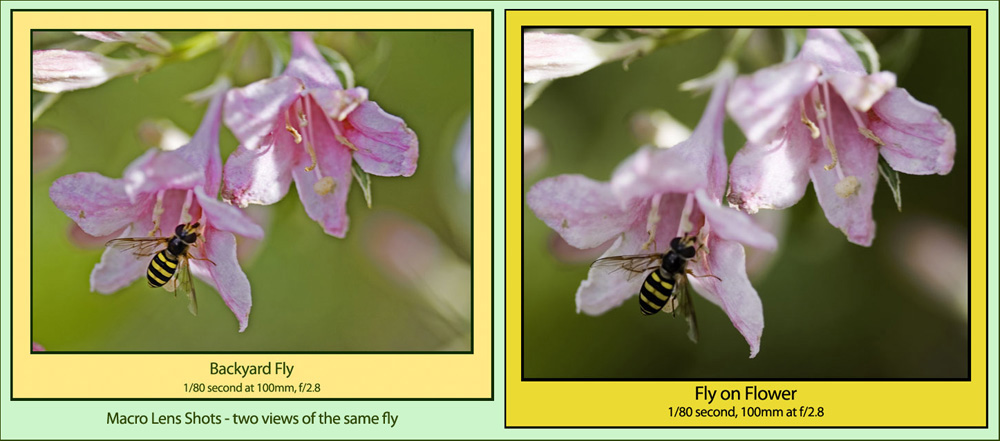
|
What's next? Well, as of mid-June what's next is on the way... I placed an order with Really Right Stuff that should preclude any upcoming tripod/mounting issues for some time to come. See the image and description below for more information. I purchased a Canon 2X EF Extender to use with the 70~200 f/2.8L IS to extend my reach and then later will investigate the purchase of a fixed telephoto in the 300 to 500mm range. These lenses cost as much as telescopes so this purchase will be put off for a time providing me an opportunity to think it through and hopefully, save some cash.
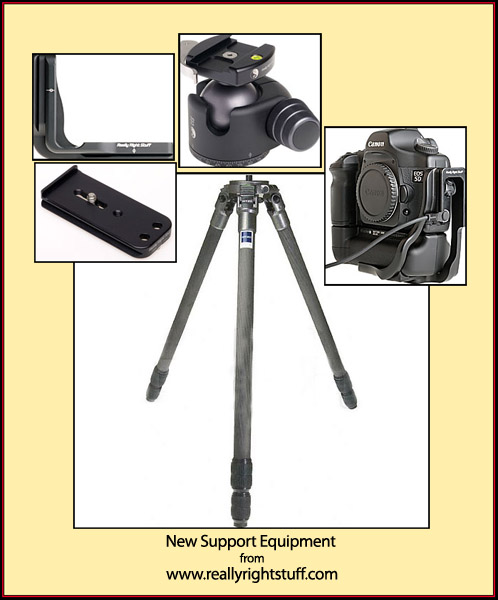
|
Photographic support equipment is much like astronomy gear from what Im learning. You can buy what you think will work and scrimp on equipment trying to save some money, or buy the equipment
youll end up with anyway from the start and save some hard-earned cash. Ive been reading, reading and reading some more and just got through a round of extremely helpful books and
web articles related to macro, bird and wildlife imaging. The general consensus is the same on tripods and mounting devices. I'd just returned from a business trip to Virginia and
while I was there recognized the validity of what these articles were indicating about movement, mirror slap and staunch support for achieving sharp images. I shot a 2 Gigabyte card full on
some wading birds and an Osprey nest; I got some decent shots, particularly on the Ospreys, (they can be viewed here:
Some Bird Photographs from Virginia)
but many of the shots hit the recycle bin due to movement or camera shake at 400mm, all the lens length
I had available. This
combined with exposure issues represents a dismal image to keeper ratio overall - I've got to say, I love digital imaging; just dump the card and start again. It was
fun and I enjoyed it at this stage in my photographic hobby, but Im also seeking results at least as good as my equipment will allow. I suppose in a sense, this is what I got as
my compact tripod is a joke with the 70-200mm f/2.8L lens with a 2X extender added to the optical train. Its been said that any support is better than none and I tested that theory in practice.
So as not to go on, when I returned I completed my research with a list of possible equipment choices and set about pricing everything up to see what I could come up with
During the course of the day I was reading some information on the Really Right Stuff website. They had one of the two tripods I was investigating in stock and several sources I read indicated this was the company to buy camera and lens plates from as these are constructed specifically for the body or lens for a perfect fit. I did the right thing, I called up, talked with a really good man named Bruce and started reviewing my needs. At the end of the discussion, I placed an order... The photograph at right indicates the components I purchased - these images came from their website. The tripod is a Gitzo G1325 Series 3 carbon fiber with a conservative load capacity of 26.5 pounds. This may not be the premier tripod for imaging birds, but I believe for my needs it will be perfect and several accounts I read support my position. Did you know your height is a consideration in purchasing a tripod? I didnt, but learned quickly enough. Next you need a ball head of some sort to place on the tripod - just like a telescope mount on a pier. My research indicated the Arca-Swiss B1 is the standard for these so I was investigating this ballhead. In the end result, after speaking with Bruce, I ordered the BH-55 LR ballhead with the B2-AS II lever release clamp. This has a 50 pound rating and I have no intention of ever exceeding that no matter how much equipment Ill ever purchase. If it gets that heavy I'll place it on my Astro-Physics 1200 GTO mount (I'm joking of course)... The way this system works is that you buy a body specific camera plate that mates with the quick release lever on the ballhead. This is what I did, the BGE4-L plate is designed for the Canon 5D with the battery grip, which I prefer to use; otherwise its a different plate model. This plate allows easy use in either a horizontal or vertical camera position. Lastly, seeing how I only have one lens that requires a specific plate, the 70-200 f/2.8L, I purchased a plate for this lens. All the other lenses mount on the 5D, which is placed into the quick mount dovetail. Lenses with individual plates are mounted in such a fashion to provide the ability to balance the system just like in astronomy where balance is critical. This system should serve me well and will accept a Wimberley 'Sidekick' gimbal device and a 500mm f/4 autofocus lens, which is about as large as I intend to go. While I was out and about recently I also purchased two-4GB SanDisk Extreme III compact flash cards Storage for imaging shouldnt be an issue in the immediate future. |
July 2006
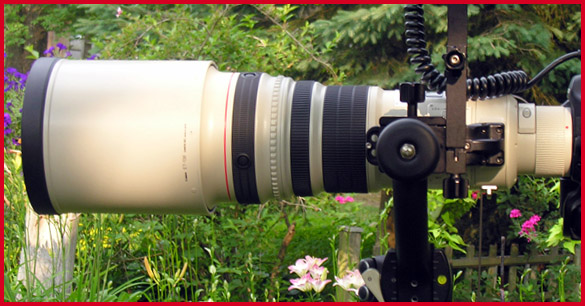
|
The quest for more focal length was met in July by the addition of a new lens, the Canon 500mm F/4L IS USM Super Telephoto. This lens at just over 15 inches and 8.5 pounds is about the limit of what my support gear can sustain. I dont plan to add anything longer but this could change as things progress. Buying this lens was as expensive as buying an apochromatic refractor for astronomy but they appear to hold value well and the technology is impressive to say the least. Id been gearing up in anticipation of this purchase and ordered a Wimberley Sidekick & flash bracket system, a Better Beamer Flash Extender, a Canon 1.4X Extender II and a RRS tripod replacement foot for the lens. I also purchased a perpendicular plate for the flash bracket so I could use this system whether it was for a telephoto lens or my shorter focal lengths including macro lenses. WIth the 1.4X extender the lens will acheive 700mm focal length and still have fully functioning autofocus capability at f/5.6.
I tested the lens in my backyard and was interested to learn how everything went together and wished to check out the stability. The sidekick is a terrific device and worked out well once balanced but overall the dampening time (the time it takes for the system to stabilize after being modified or touched) with everything set up wasnt as good as Id hoped. If this were a telescope system Id be seeking out a heavier mount. I dont see this as an insurmountable problem but it is something to be aware of when trying to obtain razor sharp images. Any movement is too much but the G1325 carbon fiber tripod handles the load quite well.
For some unfathomable reason, our yard which always has many birds around has been fairly well vacated by our avian friends in recent history. However, as I was getting everything ready to image and balancing the load, I looked over and saw this female Ruby-Throat sitting on a branch watching me. She was about 25 feet away and appeared curious and rather fearless. Find below my first shots taken with the 500mm lens:

|
I didnt see much more of interest but took some shots around the yard to check out the lens at 500mm and after a time added the 1.4X extender to see what difference this made. I took a series of images of the equipment because as they say, a picture is worth a thousand words. Find below some images of my present system:
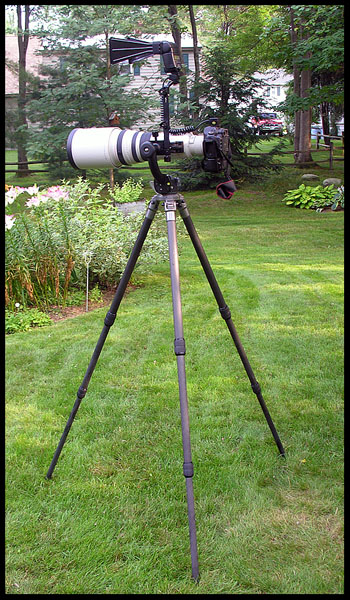
|
These views are of the imaging system with the 500mm lens mounted. The Sidekick, flash bracket and flash extender can be clearly seen to provide an idea of how this looks ready to use. Although this endeavor isn't as expensive as buying a second home or taking a vacation trip around the world, I would definately state that I'm spending my kids inheritance... |
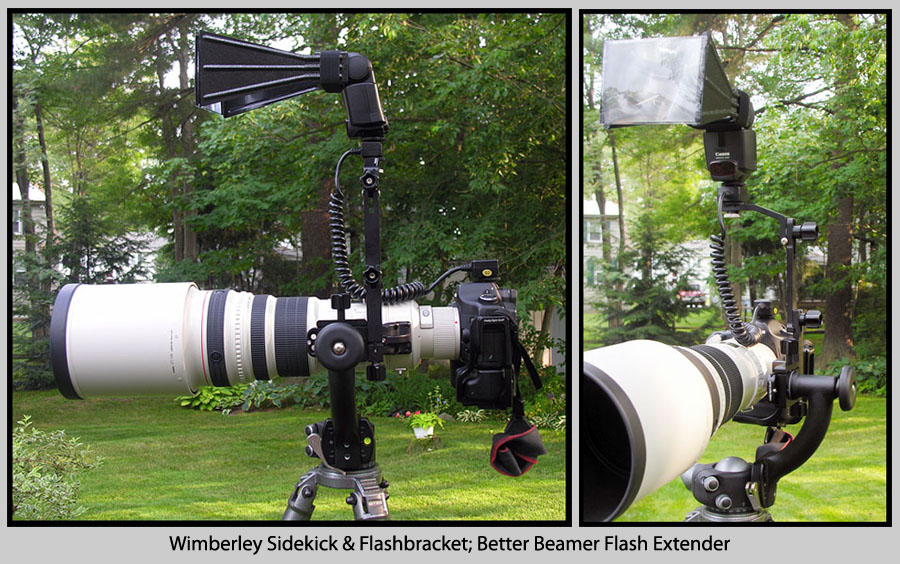
|
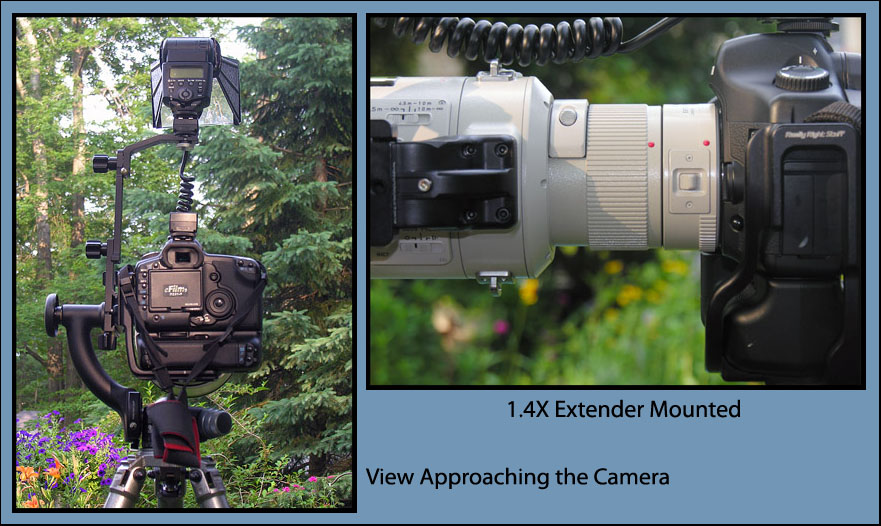
|
This system represents about all I have planned for imaging birds and other wildlife. I'm certain I'll make some additions and some new lenses but require some time to improve with the equipment I have at this time. |
The next morning, a Sunday, I was up early and decided to head to an area to try the lens at maximum reach, 700 millimeters. I drove to an area I knew had abundant birdlife around and walked down to the river. The insects were so prominent I didnt stay long because there were so many things flying around my head that to stop for any length of time was miserable. I did get some exposures in and was pleased with the end results.
I came across this spider web nicely backlit by the rising Sun. I took several images and these two were my favorites of the group. I had to back away due to the lens reach but managed to keep the Sun behind it to get these shots.
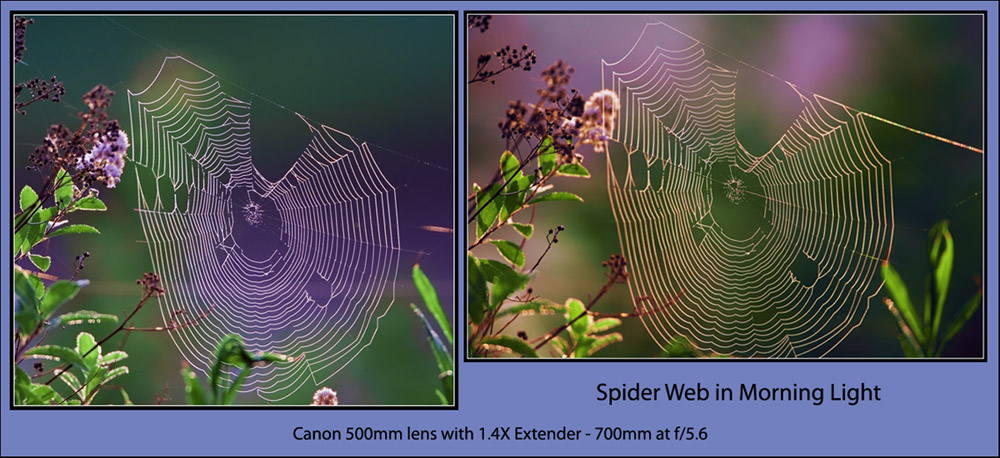
|
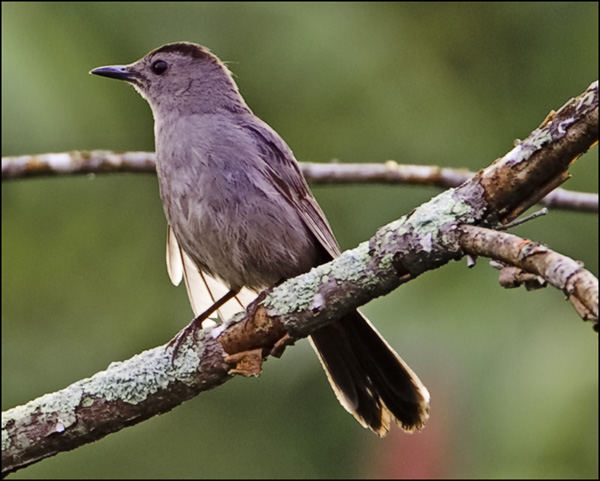
I imaged this Catbird shortly before I got ready to head home. It was only 0613 hours, still early. This image is exactly what I was hoping to achieve. A photograph like this makes all the time and expense worthwhile to me. The image scale is wonderful; this indicates that the 500mm lens and extender are okay and this is what I'd been hoping for. I can always work at getting closer to birds and other wildlife, but this reach is acceptable for my purposes. This will certainly do until the sky conditions improve and I can shoot through my telescopes again.
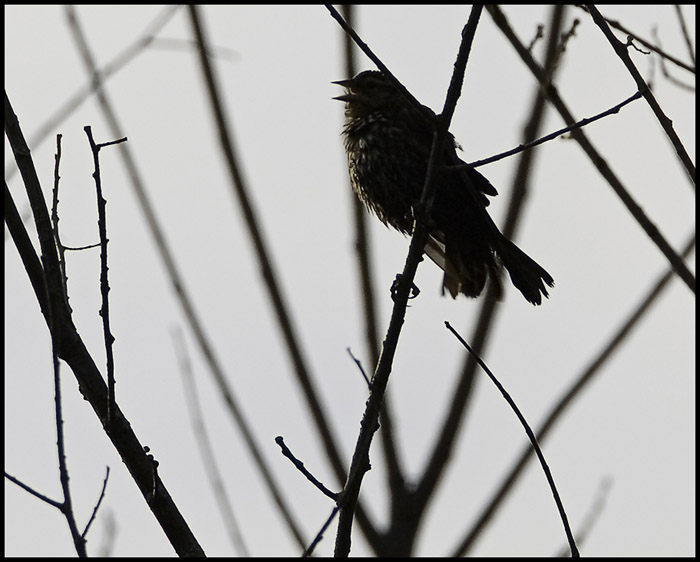
|
Sparrow singing shortly after sunrise. The bird was backlighted by the morning sun. 1/400 second at f/7.1 at 700mm; ISO 100 rating. |

|
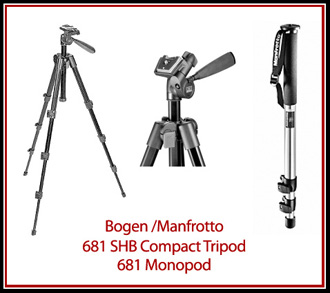
|
October 2006
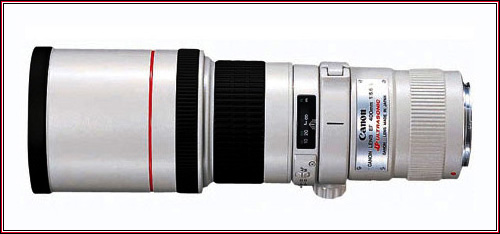
|
My newest lens - the Canon 400mm f/5.6L. This lens has the USM autofocus motor but isn't imaged stabilized. I selected this prime L lens to image birds on the wing as it's light (2.8 pounds at just over ten inches in length ) and will work well on a second body in the field in conjunction with the 5D and 500mm set up. It has an integral lens hood that pulls out in use and retracts when stored. |
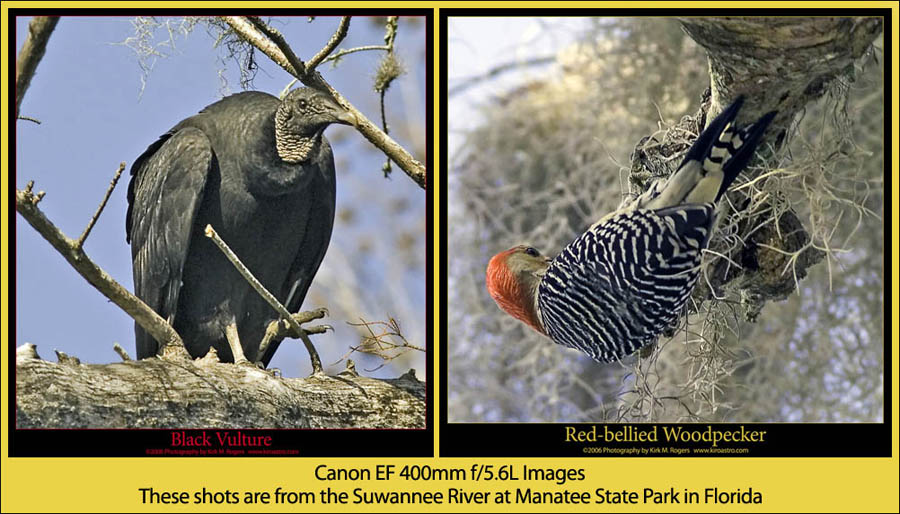
In December I traveled south to Florida for a combination work/astroimaging/earthbound photography session. I took Lindas Canon 30d body along and carried this on a strap, using the 5d on a tripod with the 500mm lens extended. This was the first good opportunity I had to test the 400mm and as can be viewed by the examples, the evaluation indicates it is quite good. It wasnt all good news however; I had difficulty using this un-stabilized lens handheld and many of the photos were deleted due to movement. Bird imaging keeps one often in lowlight conditions and even shooting wide open can prove a challenge. Shooting birds in flight was easier than handholding this assembly as you would for a normal image (although still not exactly easy by any means). I learned to use whatever support may have been around me at the time, a tree, a post, a railing, etc., anything to aid the effort to keep my body stable as I took the exposure. If operator error doesnt creep in, this lens will provide excellent results and I am more than pleased with the performance and resolution.
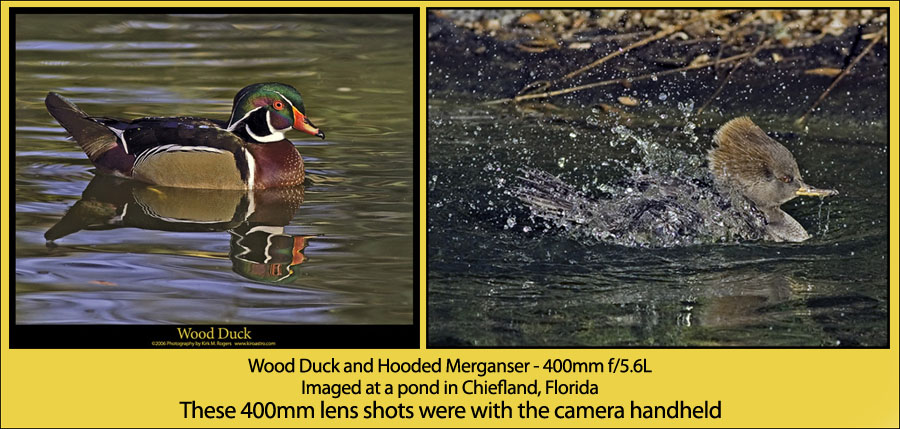
I added many new images to my Bird Index as well as a group of astronomy images from this trip. The bird photography was much more successful than the astronomy portion but I was in the field with some goods imagers and learned much from their collective wisdom.
|
I actually have a second body to use in the field from time to time I purchased a Canon 30D body for my significant others birthday in September. Im hoping she will enjoy
photography as much as I do and we can do some imaging together sharing my lens set until she learns what type of imaging she prefers and gears up on her own. However, she indicated she wouldnt mind if I
used the 30D on field trips, especially on those where the goal is to take time off from work and image birds like wintertime in the southern states for example. I plan to add
a second Canon body for my own use soon, but rather than buy another 5D, even with the decreased expense & Canon rebates being offered through early 2007, Ill wait until Canon comes out with their new
line of pro cameras, save up and upgrade then. |
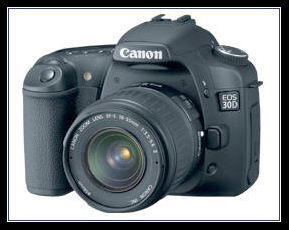
|
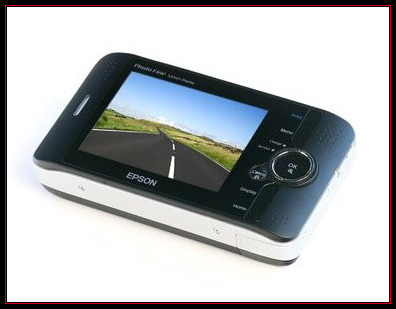
|
I purchased an Epson P-2000 multimedia storage drive to use remotely for image back-up in the field. All you need to do is insert your compact flash card and have the device copy the information so you have a duplicate for safetys sake. This is the smaller version Epson makes; a 40-Gigabyte capacity is adequate for my needs as its unlikely Ill shoot more than that at any one time without getting back to my computer (the equivalent of 10 full cards at 4GB each). Its portable, will fit in my gear bag and has a 3.8 inch LCD screen to view the images. You can also zoom the view which is helpful when evaluating the images before a computer download. |
|
Id been traveling for work all summer and with autumn well underway, had some time to consider changes and other avenues to investigate. Id been shooting often,
nearly everyday depending on my schedule - birds, some
landscapes, more birds- perched and on the wing as well as other animals Id come across when out with my camera. This had me spending a good deal of time at the computer as
all my digital capture was in RAW format but all things considered, I really enjoy doing this.
Id been doing some macro imaging and decided Id like to continue this pursuit. To this end, Id been reading up on equipment and techniques and how best to align the focal plane of the camera with the object one is imaging to achieve critical focus. With a macro lens this isnt as easy as one may expect, the field of view is extremely shallow and if youre shooting an insect, you have to get fairy close. I believe theres a Canon 180mm f/3.5L lens looming in my immediate future and this had me thinking about the support/composition aspects. I checked various equipment available in the market and decided to stay with Really Right Stuff products to add some versatility to my efforts I required a Panning Clamp Base for several reasons, to level the camera platform quickly if shooting in the field with the tripod and to have the ability to shoot panoramic views. Having the tripod leveled up is mandatory if you plan to take multiple exposures and stitch them in Photoshop. I ordered the RRS version, the PCL-1 to serve this purpose. Along with this I added a PCL-Dovetail so it would be a quick release system on my ballhead and their 192 Precision Plus Package, which consist of a MPR-192 rail and mini-clamp set. This system allows one to mount the camera in landscape of portrait view using a body plate or with a footed lens so it is quite versatile. The best course of action is to purchase RRS or similiar plates that are compatible with your overall system so everything is interchangable. This is how my astronomy plates are set up utilizing a common mounting system. You can view the photographs, courtesy of the RRS website to get an idea how this works. The 192 Precision Plus set up is used for panoramic images or for macro work, where one can move the camera closer or further from the target object on the slide. The MPR-192 rail function also allows one to find the nodal point with this system for panoramic images. |
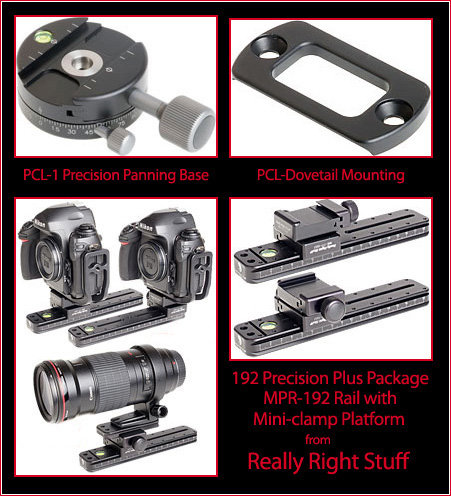
|
December 2006 into 2007
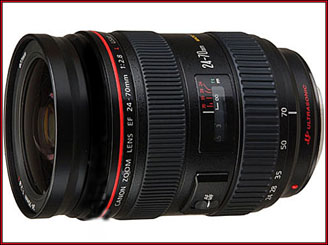
|
I returned home from my Florida excursion a few days before Christmas. Both Linda and I had visited our local Hunt's Photo so we each got a few Holiday goodies related to photography. I bought her a Canon EF24~70 f/2.8L lens that she could use for general shooting on her 30D. She provided me with two excellent polarizer filters, one that would cover several lenses in my set & one for my 500mm f/4L lens, plus a Canon 580EX Speedlight. So we are even more advantageously geared up and ready for a photographic 2007. |
2007 The Year in Review
Photographing Pelagic Birds at SeaThis account is about a day at sea seeking birds from the vessel Odyssey. It was a productive and interested event sponsored by the Wild Bird Center of Yarmouth.I also created two 'Special Edition Galleries' from several other trips in Maine waters that I didn't develop into photojournals. These are posted in the 'Bird Index' or can be noted below. Derek Lovitch put together a half day trip to view terns off Portland Harbor. This Lucky Catch Tern Cruise in early August was conducted in rough water. The sea was running enough that we nearly turned back but managed in the end to persevere. Another pelagic birding trip was undertaken in mid-August. Pelagic Birding II documents this time at sea and also has a series of images taken at sunrise. |
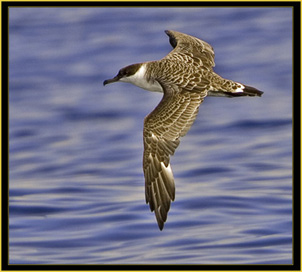
|
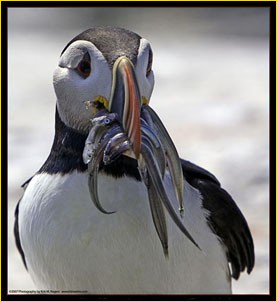
|
Photographing Atlantic Puffins via Harley-DavidsonJust as it sounds, this is a journal of a road trip on my motorcycle to Grand Manan in New Brunswick, Canada with the ultimate purpose of a visit to Machias Seal Island to photograph puffins and other birds. This was an outstanding adventure documented by this account. |
A Southern Tour at 400mmThis photojournal documents time in and around Savannah, Georgia when I was in that area on business. Because I traveled by air, I was limited in my equipment selection, thusly the Canon EF 400mm f/5.6L was my primary lens employed for photography on this junket. I did have one other lens available but that was the extent of it. |
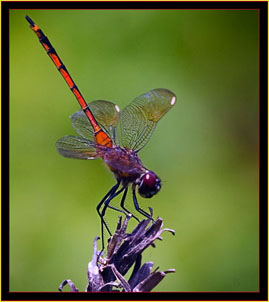
|
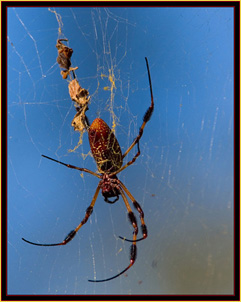
|
Photographs from GeorgiaIs a photojournal detailing more of the same as noted above in Savannah and the surrounding areas. I spent a good deal of time imaging in South Carolina on this trip. |
A Weekend on Monhegan IslandIs an account closer to home of a weekend birding with the cameras ten miles off the Maine coast. |
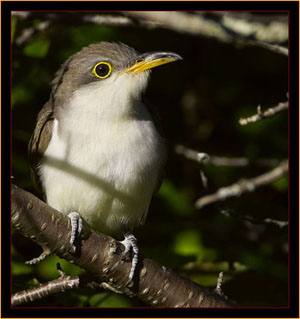
|
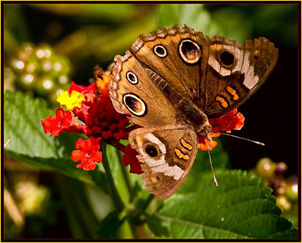
|
Southern Photography - More Travels with a CameraThis is the most recent 2007 photojournal and consists of photographs taken through late fall in Florida, Georgia & South Carolina. I was in Savannah for an extended stay and made the most of being away from home when it came to time in the field. This is probably my most ambitious account to date (read this as longest) as I had many images taken over two months. |
In October I ordered one of the new professional offerings from Canon, the EOS 1D Mark III camera. Unfortunately, I had only a weekend to decide to keep or return the camera. In the end result, I returned it out of concern with known focus issues as this problem was directly related to bird photography and quick moving subjects. If I determined the camera experienced this problem, some bodies did, others didnt apparently, I still would have had the Canon warranty but thought it was just too expensive a purchase to take the risk. My weekend with the camera indicated some surprising results The bird flight images I took were quite good in my estimation supposedly the cameras weak point. However, some of the more or less static shots with the 1D Mark III on my 500mm lens tripod mounted did not meet my expectations. Ken Schmidt, a friend, fellow astronomer and bird imager, had owned and returned two of these bodies. Using the information gleaned from he and others helped guide my decision. I retained the test shots and intend as time permits, to write an article about my findings. I will comment without equivocation however, that this camera is a thing of beauty and I surely regretted returning it.
Since I purchased and returned this camera Canon has announced a finding of a mirror issue with the 1D Mark III and instituted a recall. Photographers who purchased models with certain serial numbers can have them retrofitted with the fix and new bodies in the marketplace where recalled. The jury remains out predicated on reviews of cameras with the revisions however so many of us are waiting to see what comments may be issued in the end result. In the meantime the big daddy Canon EOS 1Ds Mark III, with a 21.9 Megapixel CMOS sensor has been released although obtaining one would be a bit of a chore at this time with the demand so great. I would really appreciate owning one of these Canon cameras as I skipped the Mark II generation but the expense makes it a significant purchase for a non-professional imager. I placed my name on lists at several places to be notified when the 1Ds Mark III becomes available so I'll see what happens...
|
I still wished to purchase another camera. I was pleased to learn that a new order of Canon EOS 40D
bodies had been delivered to the marketplace and I was able to obtain one. Ive been using this camera since October every time I take the field and find it to be great with my EF 400 f/5.6L lens utilized as my handheld
system. Its good for birds on the wing and so far Ive been impressed with the image quality.
The 40D appears to be much more than a rehash of the 30D. The camera menus are much like the 1D Mark III and it has the updated DIGIC III image processing engine. Its supposed to be excellent at high ISO but from what Ive see so far I cant say I would purchase one with this in mind. That being said, I believe this camera to be an excellent value and one could do much with this as their primary choice. |
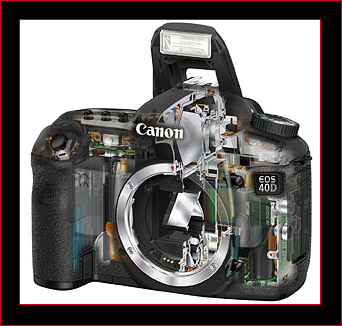
|
A Few 40D Sample Shots
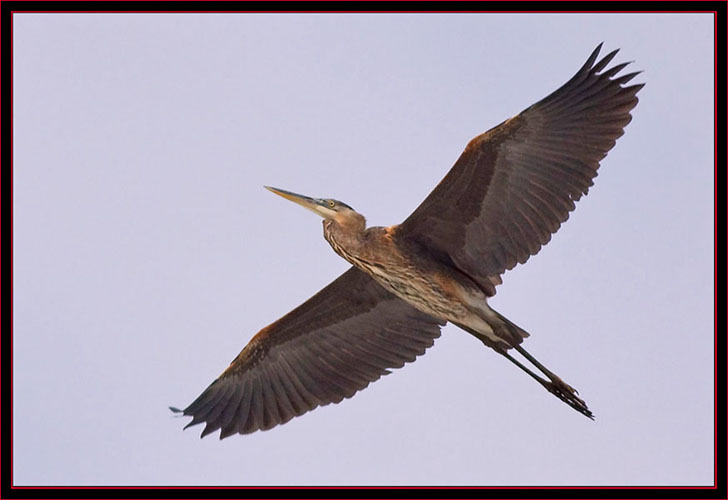
|
I was pleased with the wing shots the 40D was able to obtain from my first tests. The autofocus appeared to work well and if good technique is employed with fairly decent site conditions some good shots can be obtained. I often shoot in low-light or with poor sky conditions because I cannot always pick what days Im out so getting to know how the camera functions in different conditions is important. Great Blue Heron in flight. 1/1250 second at ISO 400; EF 400mm f/5.6L lens at f/5.6. |
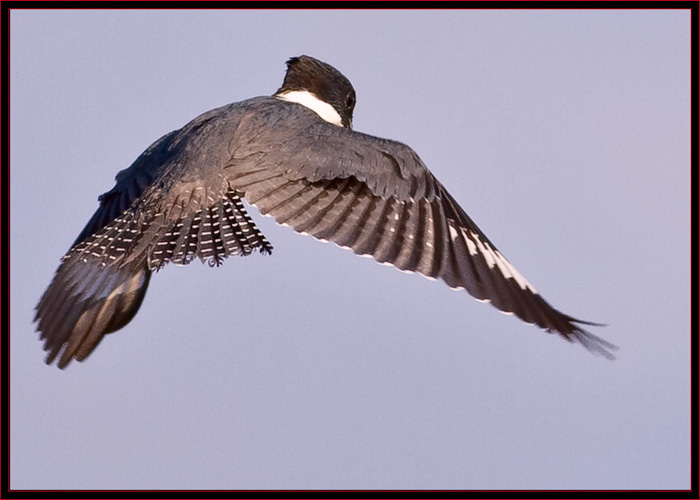
|
|
The 40D is lightweight even with the battery grip which I use to add a second battery to the camera. With the 400mm lens its a simple matter to swing
up the camera to catch a quick flight shot once the subject comes into view.
Bue-gray Gnatcatcher. 1/500 second at ISO 400; EF 400mm f/5.6L lens at f/8.
|

|
The Times They Are Achanging - 2008 to 2016
Canon Equipment in Summary - Lenses & Accessories
| TS-E 17mm f/4L | 15mm f/2.8L Fisheye | 8~15mm f/4L Fisheye | 24~70mm f/2.8L | 24~105mm f/4L |
| 35mm f/1.4L | 50mm f/1.4 | 70~200mm f/2.8L IS II | 85mm f/1.2L II | 100mm f/2.8 Macro |
| 135mm f/2L | 400mm f/5.6L | 600mm f/4L | 580EX Speedlights | 1.4X & 2X extenders |
| Canon EOS 1D X | Canon EOS-1Ds Mark III | Canon EOS 6D modified |
Wishing all of you clear skies and time to image!
2016